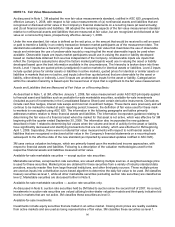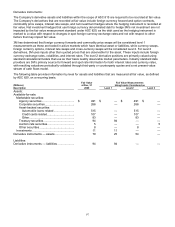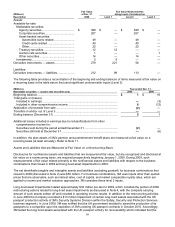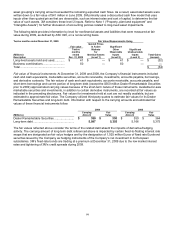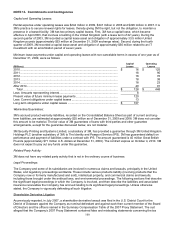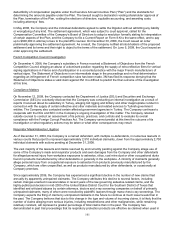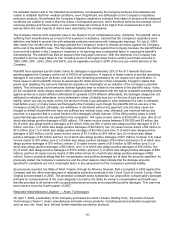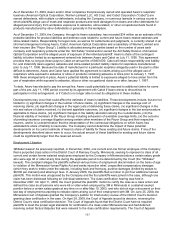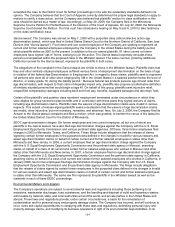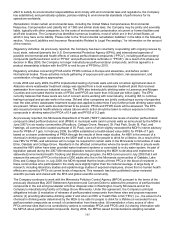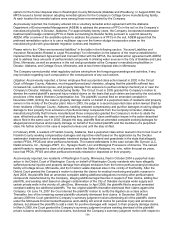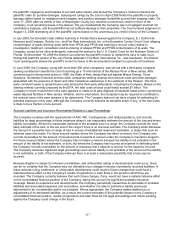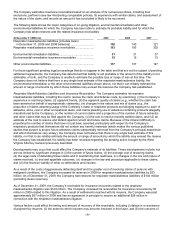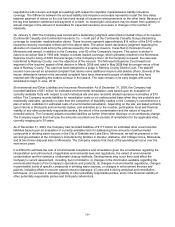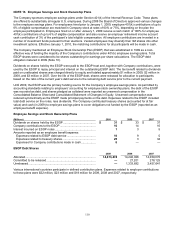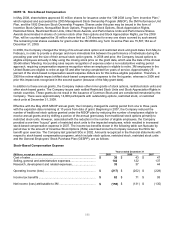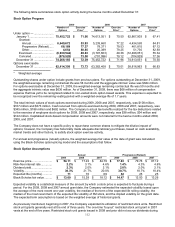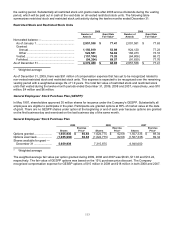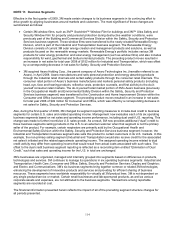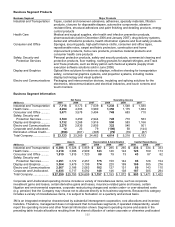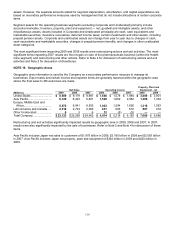3M 2009 Annual Report Download - page 112
Download and view the complete annual report
Please find page 112 of the 2009 3M annual report below. You can navigate through the pages in the report by either clicking on the pages listed below, or by using the keyword search tool below to find specific information within the annual report. 106
options for the former disposal sites in Washington County Minnesota (Oakdale and Woodbury). In August 2009, the
MPCA issued a formal decision adopting remedial options for the Company’s Cottage Grove manufacturing facility.
At each location the remedial options were among those recommended by the Company.
As previously reported, the Company entered into a voluntary remedial action agreement with the Alabama
Department of Environmental Management (ADEM) to address the presence of PFCs in the soil on the Company’s
manufacturing facility in Decatur, Alabama. For approximately twenty years, the Company incorporated wastewater
treatment plant sludge containing PFCs in fields surrounding its Decatur facility pursuant to a permit issued by
ADEM. After a review of the available options to address the presence of PFCs in the soil, ADEM agreed that the
preferred remediation option is to use a multilayer cap over the former sludge incorporation areas on the
manufacturing site with groundwater migration controls and treatment.
Please refer to the “Other environmental liabilities” in the table in the following section, “Accrued Liabilities and
Insurance Receivables Related to Legal Proceedings” for information on the balance of the reserve established to
implement the Settlement Agreement and Consent Order with the MPCA, the remedial action agreement with ADEM,
and to address trace amounts of perfluorinated compounds in drinking water sources in the City of Oakdale and Lake
Elmo, Minnesota, as well as presence in the soil and groundwater at the Company’s manufacturing facilities in
Decatur, Alabama, and Cottage Grove, Minnesota, and at two former disposal sites in Minnesota.
The Company cannot predict what regulatory actions arising from the foregoing proceedings and activities, if any,
may be taken regarding such compounds or the consequences of any such actions.
Litigation: As previously reported, a former employee filed a purported class action lawsuit in 2002 in the Circuit
Court of Morgan County, Alabama, involving perfluorooctanyl chemistry, alleging that the plaintiffs suffered fear,
increased risk, subclinical injuries, and property damage from exposure to perfluorooctanyl chemistry at or near the
Company’s Decatur, Alabama, manufacturing facility. The Circuit Court in 2005 granted the Company’s motion to
dismiss the named plaintiff’s personal injury-related claims on the basis that such claims are barred by the exclusivity
provisions of the state’s Workers Compensation Act. The plaintiffs’ counsel filed an amended complaint in
November 2006, limiting the case to property damage claims on behalf of a purported class of residents and property
owners in the vicinity of the Decatur plant. Also in 2005, the judge in a second purported class action lawsuit (filed by
three residents of Morgan County, Alabama, seeking unstated compensatory and punitive damages involving alleged
damage to their property from emissions of perfluorooctanyl compounds from the Company’s Decatur, Alabama,
manufacturing facility that formerly manufactured those compounds) granted the Company’s motion to abate the
case, effectively putting the case on hold pending the resolution of class certification issues in the action described
above filed in the same court in 2002. Despite the stay, plaintiffs filed an amended complaint seeking damages for
alleged personal injuries and property damage on behalf of the named plaintiffs and the members of a purported
class. No further action in the case is expected unless and until the stay is lifted.
In February 2009, a resident of Franklin County, Alabama, filed a purported class action lawsuit in the Circuit Court of
Franklin County seeking compensatory damages and injunctive relief based on the application by the Decatur
wastewater treatment plant of wastewater treatment sludge to farmland and grasslands in the state that allegedly
contain PFOA, PFOS and other perfluorochemicals. The named defendants in the case include 3M, Dyneon LLC,
Daikin America, Inc., Synagro-WWT, Inc., Synagro South, LLC and Biological Processors of America. The named
plaintiff seeks to represent a class of all persons within the State of Alabama, Inc. who, within the past six years,
have had PFOA, PFOS and other perfluorochemicals released or deposited on their property.
As previously reported, two residents of Washington County, Minnesota, filed in October 2004 a purported class
action in the District Court of Washington County on behalf of Washington County residents who have allegedly
suffered personal injuries and property damage from alleged emissions from the former perfluorooctanyl production
facility at Cottage Grove, Minnesota, and from historic waste disposal sites in the vicinity of that facility. After the
District Court granted the Company’s motion to dismiss the claims for medical monitoring and public nuisance in
April 2005, the plaintiffs filed an amended complaint adding additional allegations involving other perfluorinated
compounds manufactured by the Company, alleging additional legal theories in support of their claims, adding four
plaintiffs, and seeking relief based on alleged contamination of the City of Oakdale municipal water supply and
certain private wells in the vicinity of Lake Elmo, Minnesota. In April 2006, the plaintiffs filed a second amended
complaint adding two additional plaintiffs. The two original plaintiffs thereafter dismissed their claims against the
Company. On June 19, 2007 the Court denied the plaintiffs’ motion to certify the litigation as a class action.
Thereafter, two of the remaining named plaintiffs voluntarily dismissed their claims. In December 2008 and
January 2009 the Court granted the Company’s summary judgment motions dismissing all of the plaintiffs’ claims
under the Minnesota Environmental Response and Liability Act and all claims for personal injury and emotional
distress, but allowed the plaintiffs to add a claim for punitive damages with respect to their property damage claims.
In March 2009, the Court granted the Company’s summary judgment motions seeking dismissal of the plaintiffs’
private nuisance and trespass to blood claims, but denied the Company’s summary judgment motion with respect to


